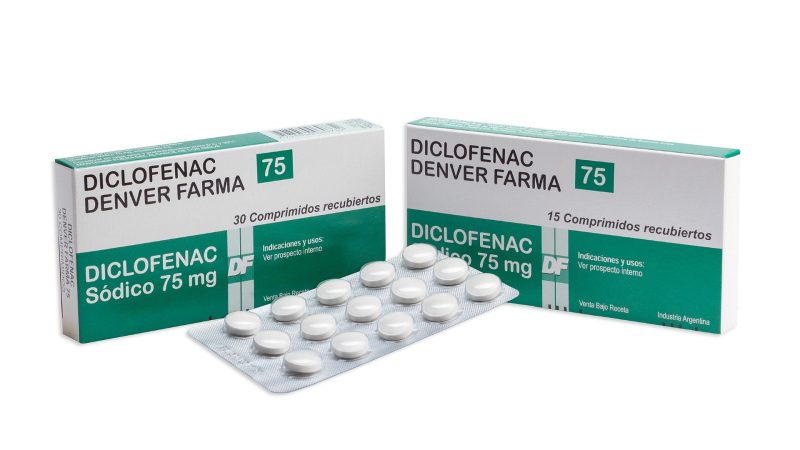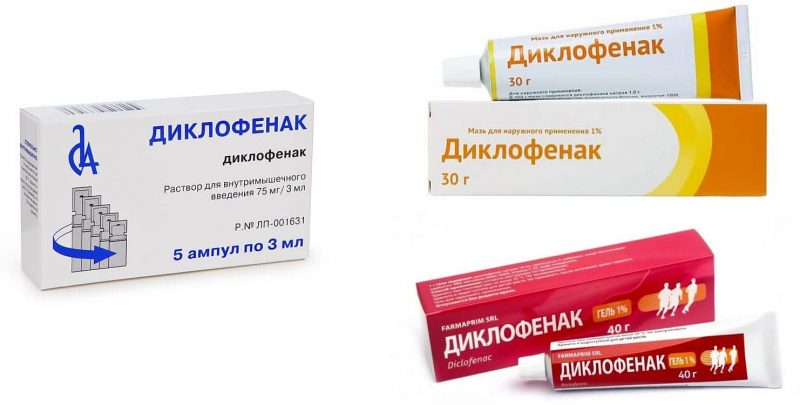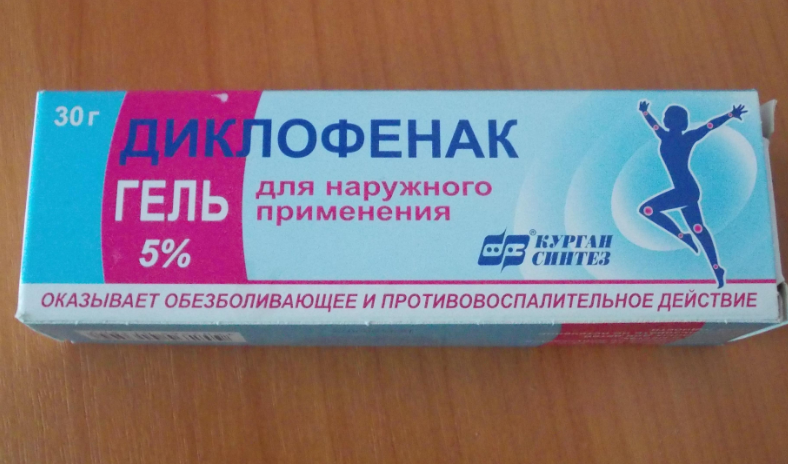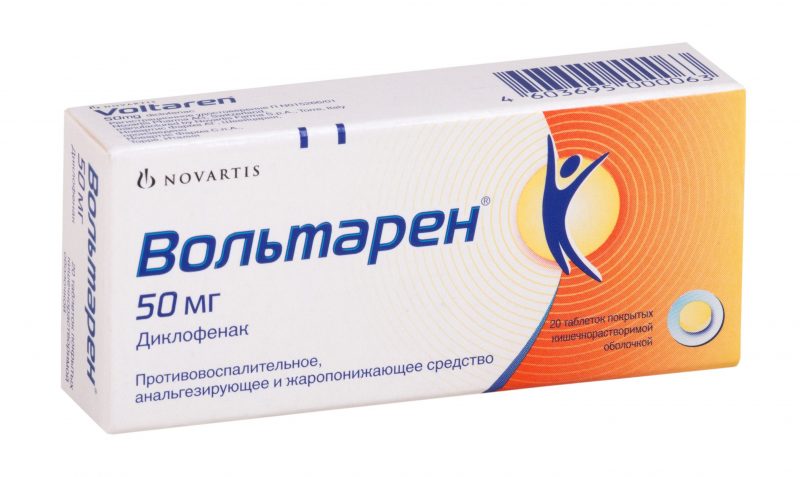Diclofenac is on the list of important drugs - a strong analgesic effect is combined with anti-inflammatory properties, and the drug is not only used to treat rheumatological diseases, but also in related fields - ophthalmology, sports medicine, etc. But in many countries they propose to ban such a drug because of the large the number of side effects, so it is important to understand what Diclofenac is from and how to apply it.
Material Content:
- 1 Composition (active substance), release form
- 2 Pharmacological properties and pharmacokinetics
- 3 What helps Diclofenac
- 4 Instructions for use for children and adults
- 5 Can I use it during pregnancy and lactation?
- 6 Drug interaction
- 7 Alcohol compatibility
- 8 Contraindications, side effects and overdose
- 9 Diclofenac analogues
Composition (active substance), release form
The decisive activity is shown by the main substance - diclofenac sodium. A significant area of application led to the presence of six forms in which the drug is produced.
The first is tablets on the market of 25 mg, 50 mg and 100 mg of the active substance. Among the additional components are silicon dioxide, lactose and cellulose, potato starch, calcium stearate. They look like flat tablets in the form of a small circle with a dash in diameter. The color of the pill is white.
The next option in which you can meet Diclofenac is suppositories (candles). The components, in addition to the main substance (50 or 100 mg), include solid fat, silicon dioxide, migliol 812. They look like oblong candles of white or cream color.
Sometimes an injection is used.It is available in small ampoules with a clear liquid inside. Each contains 25 mg of diclofenac, as well as sodium hydroxide, food additives E421 and E223, propylene glycol, benzyl alcohol and special water for injection.
The dermal spray is available in 30 or 50 ml vials with a spray nozzle. Inside is a liquid with a slight yellow tinge, in 1 ml of a solution of 40 ml of the main substance, as well as other components: medical alcohol - 96%, oils (peppermint and castor), sodium phosphate, propylene glycol, additives E216 and E218, hydrochloric acid, water.
Diclofenac eye drops - small 5 ml vials or 1 ml tubes with a special dropper. Inside is a clear or yellowish white liquid. 1 mg of the active substance is added per 1 ml of the drug. Auxiliary components: boric acid, sodium thiosulfate, potassium chloride, edetate disodium, purified water.
Pharmacological properties and pharmacokinetics
Diclofenac is valued for its fast-acting analgesic, anti-inflammatory, and antipyretic effects. It belongs to NSAIDs - non-steroidal anti-inflammatory drugs, the mechanism of action of which is based on the inhibition of the formation of prostaglandins. These are substances that are involved in the creation of pain, fever and the appearance of foci of inflammation.
The exact principle of the action of NSAIDs remains uncertain, but the effectiveness of the drug to eliminate pain against the background of rheumatic and non-rheumatic diseases, and soothe migraine attacks has been proven.
Diclofenac quickly enters the bloodstream through the intestines, but due to the coating on the tablet or candle, this process is delayed. With a single dose of a tablet (50 mg), the maximum level of the drug in the blood is observed after 1.5-2 hours - about 1.5 μg per 1 ml.
It is processed mainly in the liver, excreted in the urine - 60% of the total volume of metabolites, the remaining 40% - with bile.
The bioavailability indicator is 82%. It binds well to proteins in the blood (99.7%).
What helps Diclofenac
The tool is used to treat certain diseases of the musculoskeletal system, characterized by severe pain syndrome, for example, ankylosing spondylitis, rheumatoid arthritis, osteoarthritis and osteoarthritis.
Used to eliminate painful sensation in the postoperative period, with injuries of the spine, joints and muscles.
Diclofenac suppositories can be used to eliminate inflammation due to genital diseases - adnexitis, dysmenorrhea.
In acute infectious diseases, accompanied by inflammation, swelling and severe pain (tonsillitis, pharyngitis, otitis media), headache with migraines, can be used as an additional tool with an analgesic effect, but not replace the main therapy.
Instructions for use for children and adults
There is a special instruction for each form of release of the analgesic to prevent the use of the drug for other purposes.
Before taking one of the varieties of Diclofenac, you need to consult a specialist, familiarize yourself with the applied method of administration and only then proceed with treatment.
Diclofenac tablets 100 mg
As a rule, over 150 mg per day are not prescribed. The initial dose for severe pain is 100-150 mg. It is divided into two or three doses of ½ tablet. It is taken with food, washed down with a glass or any other volume of liquid.
With a longer treatment or less severe pain (this is determined only by the doctor), up to 100 mg of the substance is prescribed. The number of receptions can be reduced.
Gel 5%, candles
Diclofenac ointment is applied in a small amount to the affected area of the skin, gently rubbing the composition. The procedures are carried out 3-4 times a day. Do not use the gel for longer than two weeks.
Wash off hands after use and avoid ingestion.
Treatment with suppositories is carried out only rectally: do not use like tablets and other varieties of the drug. Enter into the anus smoothly, deeply. Doses and number of doses are as indicated for Diclofenac tablets.
Injections
The solution for infusion is administered intravenously or intramuscularly. You can not use the drug as a bolus injection (in large quantities for speed).
The first type of injection should be carried out directly into the upper part of the gluteal muscle, introducing the needle quite deeply. The standard dose is 1 ampoule of the drug (75 mg). With significant pain or severe inflammatory processes, 2 ampoules can be used, but not more than 150 mg per day.
For intravenous use, you will need to dilute one ampoule in 100-400 ml of solution for infusion. It can be glucose (5%) with sodium bicarbonate (in the presence of a solution of 4.2%, take 1 ml, with 8.4% - 0.5 ml), sodium chloride (0.9%). It is important that the dilution fluid is clear and fresh, just opened. Make an injection right away.
The procedure is usually prescribed to eliminate postoperative pain. The drug is administered for 30-120 minutes, the volume of the active substance is 75 mg. For a day, you can enter the amount of anesthetic, not exceeding 150 mg.
Eye drops
Drops are intended solely for use in the conjunctival sac of the eye. Before instillation, pierce the tip of the cap.
For various diseases of the organs of vision, specific doses of Diclofenac are determined, they are presented in the table below.
| Disease | Dose (number of drops) | The number of receptions per day | Course duration |
|---|---|---|---|
| Inflammation after surgery | 1 | 4 | 28 days |
| Corneal damage (minor but with severe pain) | 1 | 4 | 2 days |
| Discomfort and pain after PRK | 2 drops per hour before the procedure (divided in two doses), 2 - in the next 5 minutes after the operation (divided into two doses), 1 - every 2-4 hours for 24 hours after the procedure | ||
| Inflammation after ALT | 1 drop within 2 hours before surgery (4 times), 1 drop over the next week (4 times a day) | ||
| Allergic conjunctivitis | 1 | 4 | Until symptoms disappear |
| Surgical treatment of strabismus | 1 | 4 (first week), 3 (second week), 2 (third and fourth weeks) | 3-4 weeks |
| Postoperative pain after radial keratotomy | 1 drop before surgery, the same amount after, 1 drop 4 times a day for 2 days | ||
| Intraoperative myosis (prevention) | 1 | 4 | 2 hours before surgery |
Can I use it during pregnancy and lactation?
There are no data on specific negative symptoms of the effects of diclofenac on fetal development during pregnancy. Animal experiments have shown the harmlessness of the drug in the first and second trimesters of pregnancy (with the exception of Diclofenac injections - they cannot be used throughout the entire period of gestation), but in recent weeks there is a high probability of difficulty in childbirth or premature closure of the arterial flow in the child.
When breastfeeding, the drug enters the body of a newborn, but not more than 0.1% of the mother’s dose, which will not affect the baby’s health. Doctors prefer to refrain from using Diclofenac during pregnancy and lactation.
An exception is gel, the use of which is unlikely to harm the body of both the mother and the child. It is necessary to abstain from it in the third trimester, and when breastfeeding, do not cover the mammary glands or large areas of the skin with the product.
Drug interaction
Based on medical practice, the interaction of Diclofenac with certain drugs is known. The data are presented in the table below.
| A drug | Effects on the body |
|---|---|
| Anticoagulants | Increased risk of internal bleeding |
| SSRIs (selective serotonin reuptake inhibitors) | Perhaps the appearance of a gastrointestinal hemorrhage |
| Methotrexate | An increase in the level of methotrexate in the blood, in excess of the permissible dose - intoxication |
| Drugs that increase potassium levels | Excessive Potassium in Plasma |
| Diuretics | Dehydration, nephrotoxicity |
| Other antihypertensive agents | Leveling the effect of drugs |
| NSAIDs | High probability of gastric ulcer or gastrointestinal bleeding |
| Drugs for diabetes | Hypoglycemia / Hyperglycemia |
| Quinolone derivatives | Cramps |
| Cholestyramine and cholestipol | Decreased diclofenac absorption rate |
| Cardiac Glycosides | The aggravation of existing disorders, a high concentration of glycosides in the blood |
| Mifepristone | Reducing the effect of mifepristone on the body |
| Phenytoin | Increased blood phenytoin concentration |
| Lithium | An increase in the amount of lithium in the blood |
| Digoxin | Excess Digoxin in Plasma |
Alcohol compatibility
It is strictly forbidden to drink alcohol during therapy with diclofenac.
The least dangerous side effect of this combination is a decrease in the medicinal properties of the drug. But the manifestation of only one negative action is unlikely. Due to the increased load on the liver, which processes both diclofenac and ethanol, significant organ disturbances are possible.
Negative effects on the cardiovascular system. Significantly increased blood pressure, up to a state of hypertensive crisis. The likelihood of such a reaction increases with the intravenous administration of the drug and the subsequent intake of alcohol.
Contraindications, side effects and overdose
The drug can not be taken in the following cases:
- children's age (up to 14 years);
- last weeks of pregnancy;
- ulcers or disorders accompanied by bleeding, especially after taking other NSAIDs;
- inflammatory diseases of the gastrointestinal tract;
- coronary heart disease, recovery period after stroke, pathology of peripheral arteries;
- pain after coronary artery bypass grafting;
- allergy after taking other NSAIDs;
- heart, kidney, or liver failure;
- violations of the hematopoietic function of the body;
- intolerance to one of the components of the drug.
Among the possible side effects are observed:
- allergies in the form of redness on the skin, urticaria, angioedema, anaphylactic shock, fever;
- neurotic disorders;
- “Fog” before the eyes, difficulty focusing vision, optic neuritis;
- hearing impairment, tinnitus;
- asthma, pneumonitis;
- anemia, a decrease in the level of platelets, white blood cells, agranulocytosis (rarely);
- disorientation, insomnia, nightmares, irritability;
- acceleration of heartbeat, chest pain, shortness of breath, hypertension / hypotension (abnormal increase or decrease in blood pressure), heart attack, worsening or development of heart failure;
- dyspeptic disorders, anorexia, the development of gastritis, stomach or intestinal ulcers, less often - perforation, stomatitis, gastroenteropathy;
- eczema, hair loss, exfoliative dermatitis, erythema, Lyell, Stevens-Jones syndromes;
- liver failure, jaundice, hepatitis, liver necrosis;
- renal failure, hematuria, nephrotic syndrome, nephritis.
Diclofenac is cautious because of its ability to provoke thrombotic complications, even death. because drug treatment should be carried out during the shortest course with minimal doses.
An overdose is not characterized by specific symptoms, as each patient manifests itself differently. Violations in the activity of the gastrointestinal tract, or neurological phenomena - disorientation, irritability, hypersensitivity can be recorded.
With severe intoxication, signs of acute renal or liver failure are detected, so there is no specific treatment for overdose. Only symptomatic therapy is indicated.If there are severe manifestations, a doctor's intervention is mandatory. Before that, you need to drink activated charcoal or rinse your stomach.
Diclofenac analogues
The most similar in composition and indications for use is the Swiss drug Voltaren. Due to the lower concentration of the active substance, it is recognized as more sparing for the body, but the side effects are similar, which requires caution during therapy.
Another Swiss counterpart - Diklak - is used for inflammatory manifestations of rheumatism, muscle damage, for the treatment of pain after surgery. The main advantage of the drug is the ability to treat children from 6 years old.
The Israeli drug Diklonat P has similar indications, doses, contraindications, but it has been proven in clinical practice that the drug is tolerated better than the standard Diclofenac, because side effects are less pronounced, more often appear as an allergy, and there have been no cases of fatal outcome. Approved for the treatment of patients from 6 years.
Among the other analogues of Diclofenac, the following drugs were noted:
- Naklof;
- Diclosafe;
- Naklofen;
- Doloxene;
- Bioran;
- Diclovit;
- Veral;
- Ortofen;
- Rapten
- Nerges;
- Difthal;
- Evinopon.
Diclofenac is an effective pain medication that is actively used to treat inflammatory conditions of rheumatic and non-rheumatic origin. But it is important to strictly follow the doctor’s instructions when taking this remedy - the drug has a large number of side effects, some are life-threatening. The risk is minimal if you use the medicine for a short period of time and do not exceed the assigned doses.
























